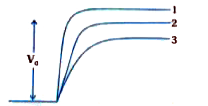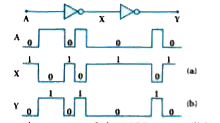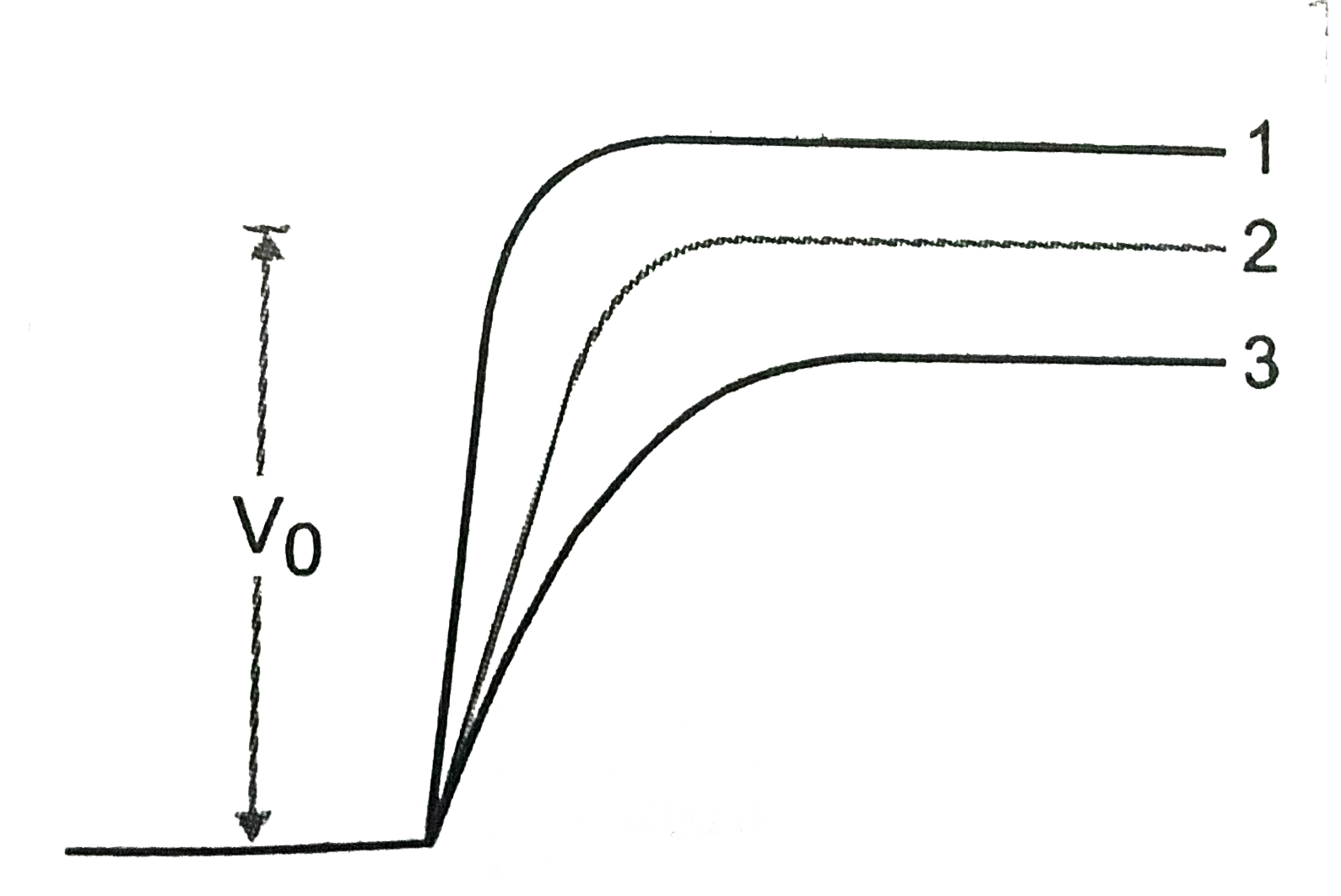
In figure, Vo is the potential barrier across a p-n junction, when no battery is connected across the junction. Solution in Gujrati
1 and 3 both correspond to forward bias of junction.
3 corresponds to forward bias of junction and 1 corresponds to reverse bias of junction.
1 corresponds to forward bias and 3 corresponds to reverse bias of junction.
3 and 1 both correspond to reverse bias of junction.
The correct Answer is:B
3 corresponds to forward bias of junction and 1 corresponds to reverse bias of junction.
When p-n junction is forward biased, magnitude of barrier potential (i.e. height of potential barrier) becomes smaller than V0, which is seen in graph 3.
When p-n junction is reverse biased, magnitude of barrier potential becomes greater than V0, which is seen in graph 1.
Thus, option (B) is correct.
Topper's Solved these Questions
- BOOK - KUMAR PRAKASHANCHAPTER - SEMICONDUCTOR ELECTRONICS : MATERIALS, DEVICES AND SIMPLE CIRCUITS EXERCISE - Section-C: NCERT Exemplar Solution (Multiple Choice Qustion (More than One Options))8videos
SEMICONDUCTOR ELECTRONICS : MATERIALS, DEVICES AND SIMPLE CIRCUITS
- BOOK - KUMAR PRAKASHANCHAPTER - SEMICONDUCTOR ELECTRONICS : MATERIALS, DEVICES AND SIMPLE CIRCUITS EXERCISE - Section-C: NCERT Exemplar Solution (Very Short Answer Type Questions)6videos
SEMICONDUCTOR ELECTRONICS : MATERIALS, DEVICES AND SIMPLE CIRCUITS
- BOOK - KUMAR PRAKASHANCHAPTER - SEMICONDUCTOR ELECTRONICS : MATERIALS, DEVICES AND SIMPLE CIRCUITS EXERCISE - Section-B : Numericals (Numerical From .DARPAN. Based On Textbook)14videos
SEMICONDUCTOR ELECTRONICS : MATERIALS, DEVICES AND SIMPLE CIRCUITS
- BOOK - KUMAR PRAKASHANCHAPTER - SAMPLE QUESTION PAPER EXERCISE - PART-B SECTION-C5videos
SAMPLE QUESTION PAPER
- BOOK - KUMAR PRAKASHANCHAPTER - WAVE OPTICSEXERCISE - SECTION-D (MULTIPLCE CHOICE QUESTIONS (MCQS)) (MCQS FROM DARPAN BASED ON TEXTBOOK)239videos
WAVE OPTICS
Similar Questions
When an electric field is applied across a semiconductor
02:05View SolutionWhy are elemental dopants for Silicon on Germanium usually chosen from group XIII on group XV ?
03:35View SolutionA logic circuit is shown in the diagram. Draw the output signal at the point X and Y for the input signal shown in the figure at point A.
 03:05View Solution
03:05View SolutionTwo charges –q and +q are located at points (0, 0, –a) and (0, 0, a), respectively.
(a) What is the electrostatic potential at the points (0, 0, z) and (x, y, 0) ?
(b) Obtain the dependence of potential on the distance r of a point from the origin when r/a>>1 .
(c) How much work is done in moving a small test charge from the point (5,0,0) to (–7,0,0) along the x-axis? Does the answer change if the path of the test charge between the same points is not along the x-axis?00:58View SolutionAccording to particle theory of light what is the velocity of light in a dense medium, compared to that in rare medium ?
View SolutionCan the potential barrier across a p-n junction be measured by simply connecting a voltmeter across the junction ?
00:57View SolutionIn Fig . V0 is the potential barrier across a p-n junction, when no battery is connected across the junction
 View Solution
View SolutionIn Fig. V_(0) is the potential barrier across a p-n junction, when no battery is connected across the junction : .
01:15View SolutionCan the potential barrier across a p−n junction be measured by simply connecting a voltmeter across the junction ?
03:35View SolutionIf a battery is connected across a p-n junction with p-type connected to the negative terminal, the junction is said to be
05:23View SolutionIf a battery is connected across a p-n junction with p-type connected to the negative terminal, the junction is said to be
02:16View SolutionCan the potential barrier across a p-n junction be measured by simply connecting a voltmeter across the junction ?
01:24View SolutionCan the potential barrier across a p-n junction be measured by simply connecting a voltmeter across the junction?
03:47View SolutionCan the potential barrier across a p−n junction be measured by simply connecting a voltmeter across the junction ?
View SolutionIn Fig . V_(0) is the potential barrier across a p-n junction, when no battery is connected across the junction
View Solution

